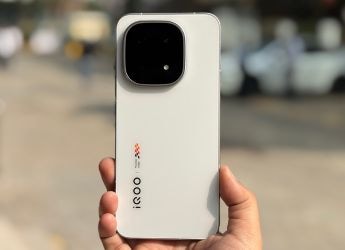- Home
- Mobiles
- Mobiles News
- Poco F1 DxOMark Camera Results Show It's Just Behind the iPhone 8 in Overall Score
Poco F1 DxOMark Camera Results Show It's Just Behind the iPhone 8 in Overall Score

Still camera performance of the Poco F1 has received 92 points on DxOMark's camera benchmarks
Poco F1 already attracted the masses with its flagship-grade Snapdragon 845 SoC at an affordable price point. However, camera benchmark portal DxOMark has now found that not just the processor but the camera of the Xiaomi phone is also one of its key advantages. The DxOMark team highlights that the camera performance of the Poco F1 is in line with the Apple iPhone 8. The phone is claimed to offer decent exposure, colour, and noise in most conditions. The provided autofocus and stabilisation also make the Poco F1 a decent option for video recording.
As per the result of various tests conducted by DxOMark, the Poco F1 has received a photo score of 92, while its video recording performance got a score of 90. The Poco F1 photo score is just behind the 93 score received by the iPhone 8 back in September 2017. However, on the video recording part, the iPhone model had got a video quality score of 90, matching the Poco F1.
Notably, the iPhone 8 currently starts at an official price of Rs. 59,900 in India, which is more than twice the price of the Poco F1 that comes with a starting price of Rs. 19,999. The Poco F1 sports a dual rear camera setup that includes a 12-megapixel primary sensor along with an f/1.9 lens and a 5-megapixel secondary sensor along with an f/2.0 lens for depth sensing. This is unlike the iPhone 8 that had a single, 12-megapixel sensor along with an f/1.8 lens and optical image stabilisation (OIS) support.
Detailing the test, DxOMark engineers underline that the Poco F1 has received an overall score of 91 points - thanks to its "very respectable performance" throughout the testing. This is below the iPhone 8's overall score of 92. The smartphone is claimed to have excellent autofocus performance and pleasant colour results in all tested conditions. Exposure on the camera setup is also said to be accurate most of the times, and sensors are found to produce high levels of contrast and accurate white balance.
![]()
Photo Credit: DxOMark
On the part of major cons, the secondary camera of the Poco F1 seems to be underperforming over the competition. HDR processing and low-light results are lagging behind the flagship phones. Further, the dual-LED flash isn't able to brighten objects accurately in the dark.
The DxOMark team observes that due to the absence of the telephoto lens on the Poco F1, zoom shots and bokeh results are on par with smartphones featuring a single camera.
In terms of video recording, the Poco F1 comes as a "reasonably consistent performer" and has excellent autofocus with good tracking and an effective stabilisation system. Colour reproduction of the sensors while recording videos is also found to be strong enough on the handset.
Having said that, target exposures, especially in bright scenes, aren't up to the mark and similar is the case with dynamic range.
"For mobile photography enthusiasts after a bargain, the rear camera puts in a respectable performance, with decent still-image results for exposure, color, and noise in most conditions," the DxoMark team writes in its review. "It's some ways behind the very best high-end devices we've tested for image quality, though, the current crop of dual or triple-cam flagship devices are a cut above—particularly for HDR processing, low light exposure, and detail, as well as for zoom and bokeh shots."
DxOMark recently started testing selfie cameras of smartphones alongside their rear camera results. However, the team hasn't yet tested the selfie camera performance of the Poco F1.
Xiaomi Poco F1 looks great value for the price, but is there a catch? We discussed this on Orbital, our weekly technology podcast, which you can subscribe to via Apple Podcasts or RSS, download the episode, or just hit the play button below.
Catch the latest from the Consumer Electronics Show on Gadgets 360, at our CES 2026 hub.
Related Stories
- Samsung Galaxy Unpacked 2025
- ChatGPT
- Redmi Note 14 Pro+
- iPhone 16
- Apple Vision Pro
- Oneplus 12
- OnePlus Nord CE 3 Lite 5G
- iPhone 13
- Xiaomi 14 Pro
- Oppo Find N3
- Tecno Spark Go (2023)
- Realme V30
- Best Phones Under 25000
- Samsung Galaxy S24 Series
- Cryptocurrency
- iQoo 12
- Samsung Galaxy S24 Ultra
- Giottus
- Samsung Galaxy Z Flip 5
- Apple 'Scary Fast'
- Housefull 5
- GoPro Hero 12 Black Review
- Invincible Season 2
- JioGlass
- HD Ready TV
- Laptop Under 50000
- Smartwatch Under 10000
- Latest Mobile Phones
- Compare Phones
- Honor Win RT
- Honor Win
- Xiaomi 17 Ultra Leica Edition
- Xiaomi 17 Ultra
- Huawei Nova 15
- Huawei Nova 15 Pro
- Huawei Nova 15 Ultra
- OnePlus 15R
- Asus ProArt P16
- MacBook Pro 14-inch (M5, 2025)
- OPPO Pad Air 5
- Huawei MatePad 11.5 (2026)
- Xiaomi Watch 5
- Huawei Watch 10th Anniversary Edition
- Acerpure Nitro Z Series 100-inch QLED TV
- Samsung 43 Inch LED Ultra HD (4K) Smart TV (UA43UE81AFULXL)
- Asus ROG Ally
- Nintendo Switch Lite
- Haier 1.6 Ton 5 Star Inverter Split AC (HSU19G-MZAID5BN-INV)
- Haier 1.6 Ton 5 Star Inverter Split AC (HSU19G-MZAIM5BN-INV)


















